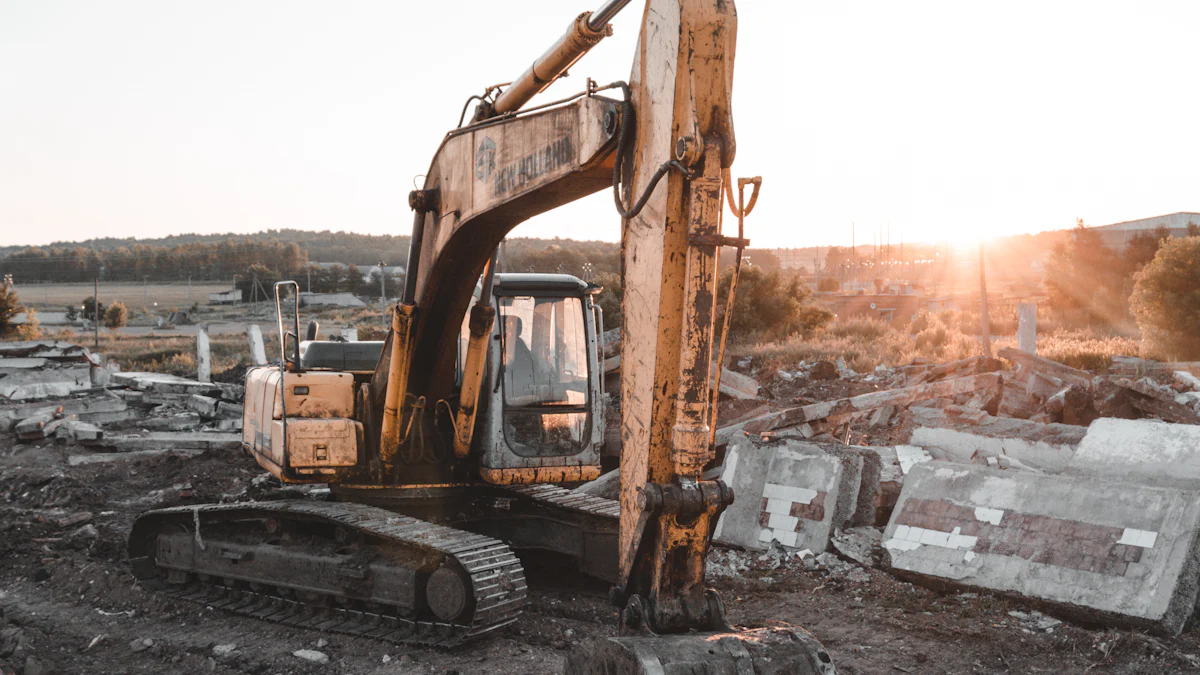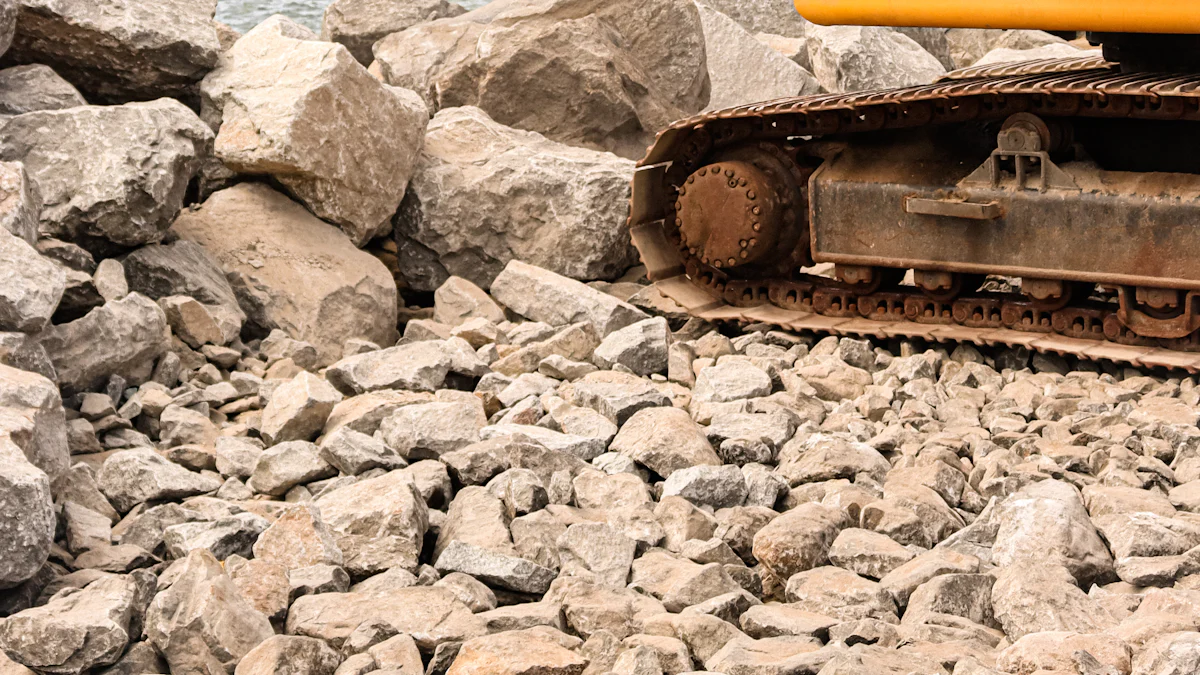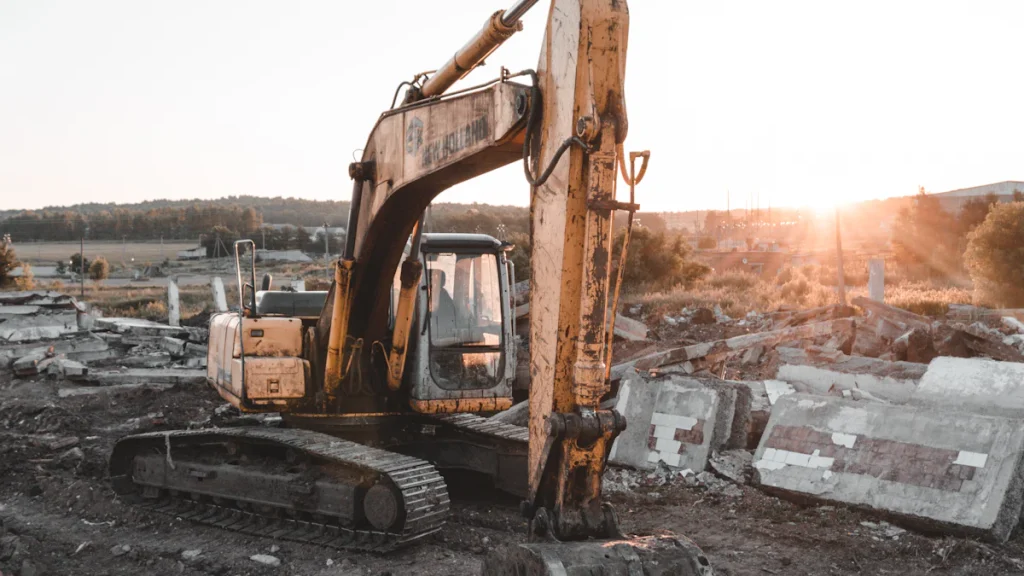
Excavator dismantlers play a vital role in modern construction and recycling industries. These specialized machines or attachments disassemble heavy equipment, such as excavators, at the end of their lifecycle. By recovering valuable components and materials, they help reduce waste and promote sustainability. Their use also enhances safety and efficiency in tasks like demolition, maintenance, and recycling. With the growing demand for environmentally friendly solutions, these tools have become indispensable for ensuring responsible resource management in construction and beyond.
Key Takeaways
Excavator dismantlers are essential for safely disassembling heavy machinery, promoting sustainability by recovering valuable components and reducing waste.
These machines enhance efficiency and safety in construction and demolition by automating complex tasks, minimizing manual labor, and reducing risks on job sites.
Utilizing hydraulic shears and clamping arms allows for precise cutting and secure handling of materials, ensuring that reusable parts remain intact during dismantling.
Investing in excavator dismantlers can lead to significant cost savings by reducing labor expenses and maximizing the value of recovered materials.
Modern electric dismantlers are energy-efficient and environmentally friendly, aligning with the growing demand for sustainable practices in the construction industry.
Choosing the right excavator dismantler involves assessing project scope, material types, and energy efficiency to ensure optimal performance and cost-effectiveness.
Regular maintenance and operator training are crucial for maximizing the lifespan and efficiency of dismantling equipment, preventing costly repairs and downtime.
What Are Excavator Dismantlers?
Definition and Purpose
Excavator dismantlers are specialized machines or attachments designed to disassemble heavy equipment, particularly excavators, at the end of their operational life. These tools allow you to safely and efficiently break down machinery into reusable components and recyclable materials. Their primary purpose is to promote sustainability by recovering valuable parts and reducing waste. In addition, they enhance safety by automating tasks that would otherwise require manual labor, minimizing risks on job sites.
By using excavator dismantlers, you can streamline processes like equipment maintenance, recycling, and demolition. These machines are essential for industries that prioritize efficiency and environmental responsibility. Whether you need to salvage parts from old machinery or prepare materials for reuse, excavator dismantlers provide a reliable solution.
Key Components of Excavator Dismantlers
Excavator dismantlers consist of several key components that work together to perform their tasks effectively. Understanding these components helps you appreciate how these machines operate:
Hydraulic Shears: These powerful cutting tools are mounted on the excavator’s arm. They allow you to cut through metal and other materials with precision and ease.
Clamping Arm: This component secures parts during the dismantling process, ensuring stability and safety. It prevents materials from shifting or falling while being disassembled.
Power Supply System: This system powers the dismantler’s various functions. In some models, such as electric dismantlers, the power supply is designed to be energy-efficient and environmentally friendly.
Specialized Excavator Frame: The frame provides the structural support needed for dismantling tasks. It is built to handle the stress and demands of heavy-duty operations.
For example, an electric quick dismantler for scrapped cars integrates hydraulic shears, a clamping arm, and a power supply system into a specialized excavator. This design ensures high performance, stability, and flexibility, making it suitable for various dismantling tasks.
How Excavator Dismantlers Operate
The operation of excavator dismantlers involves a combination of mechanical precision and hydraulic power. When you use one, the process typically follows these steps:
Positioning the Machine: You start by positioning the dismantler near the equipment or structure to be disassembled. The machine’s mobility allows you to navigate tight spaces and challenging terrains.
Securing the Target: The clamping arm holds the equipment or material firmly in place. This step ensures that the dismantling process remains safe and controlled.
Cutting and Disassembling: Hydraulic shears cut through metal, wires, and other materials. The dismantler’s precision enables you to separate components without causing unnecessary damage.
Sorting and Collecting Materials: Once disassembled, you can sort the recovered parts for recycling, reuse, or disposal. This step maximizes the value of the materials and minimizes waste.
Modern excavator dismantlers, such as electric fast dismantling machines, offer additional benefits like energy efficiency and ease of operation. These machines are designed to handle complex dismantling tasks while maintaining high performance and reliability.
Uses of Excavator Dismantlers in the Construction Industry

Equipment Maintenance and Repairs
Excavator dismantlers play a crucial role in maintaining and repairing heavy machinery. When your equipment reaches the end of its operational life or requires significant repairs, these tools help you disassemble it efficiently. By using hydraulic shears and clamping arms, you can safely remove damaged or worn-out components without risking harm to other parts of the machine. This precision ensures that reusable components remain intact, saving you time and money.
For example, specialized dismantling equipment, like the Pladdet Car Dismantler, demonstrates how precision tools can separate valuable parts without causing damage. Similarly, excavator dismantlers allow you to streamline maintenance operations by focusing on recovering and reusing functional components. This approach not only reduces downtime but also maximizes the value of your machinery.
Recycling and Sustainability
Recycling is one of the most significant benefits of using excavator dismantlers. These machines enable you to recover valuable materials, such as metals, from decommissioned equipment. By separating recyclable components, you contribute to reducing waste and promoting sustainability in the construction industry. This process also helps you minimize the environmental impact of your operations.
When you use excavator dismantlers, you can extract every usable material from old machinery. For instance, operators in the automotive dismantling industry have realized the importance of recovering more than just easily sellable parts. They now focus on maximizing the scrap value of end-of-life vehicles. Similarly, in construction, dismantlers help you recover materials that can be reused or recycled, ensuring nothing goes to waste.
Demolition and Deconstruction Projects
In demolition and deconstruction projects, excavator dismantlers provide you with a safe and efficient way to dismantle structures. These tools allow you to carefully disassemble buildings, ensuring that materials like steel, concrete, and wood can be salvaged for reuse. High-reach demolition, a specialized method, uses heavy machinery with extended arms to reach tall structures. This technique ensures controlled dismantling, reducing risks and improving efficiency.
By employing excavator dismantlers, you can handle complex demolition tasks with ease. The precision of these machines allows you to separate materials without causing unnecessary damage. This approach not only enhances safety but also supports sustainable practices by enabling the reuse of salvaged materials. Whether you are working on a small-scale project or a large demolition site, these tools help you achieve your goals effectively.
Benefits of Using Excavator Dismantlers
Improved Efficiency and Safety
Excavator dismantlers significantly enhance efficiency and safety in construction and demolition tasks. These machines streamline operations by automating complex dismantling processes, reducing the time and effort required. For instance, high-reach demolition equipment allows you to disassemble tall structures quickly while maintaining precision. This approach minimizes delays and ensures faster project completion.
Safety is another critical advantage. By using excavator dismantlers, you eliminate the need for manual labor in hazardous environments. The clamping arm secures materials during disassembly, preventing accidents caused by shifting or falling debris. Hydraulic shears cut through tough materials with precision, reducing the risk of errors. These features create a safer work environment for you and your team.
Cost-Effectiveness in Construction
Investing in excavator dismantlers can lead to substantial cost savings. These machines reduce labor expenses by automating tasks that would otherwise require a large workforce. For example, specialized vehicle dismantling equipment maximizes the value of scrap materials, ensuring you recover more from decommissioned machinery. This efficiency translates into lower operational costs.
Additionally, the durability and reliability of excavator dismantlers minimize maintenance expenses. Modern designs, such as electric quick dismantlers, offer energy-efficient solutions that reduce fuel consumption. By completing projects faster and with fewer resources, you can achieve better financial outcomes for your construction or demolition projects.
Environmental Sustainability
Excavator dismantlers play a vital role in promoting environmental sustainability. These machines enable you to recover and recycle valuable materials, such as metals, from old equipment. By reusing these components, you reduce waste and conserve natural resources. High-reach demolition methods also produce less dust, noise, and debris, minimizing the environmental impact of your operations.
Energy-efficient models, like electric dismantlers, further enhance sustainability. These machines consume less energy and produce fewer emissions, aligning with eco-friendly practices. By incorporating excavator dismantlers into your projects, you contribute to a greener construction industry while meeting environmental regulations.
Examples of Excavator Dismantlers in Action

Case Studies of Successful Applications
The transformation of traditional dismantling methods has revolutionized industries like construction and automotive recycling. For example, the shift from manual dismantling to advanced technology has allowed businesses to maximize the value of scrap materials. Operators now use specialized equipment to recover valuable components efficiently. This approach not only saves time but also ensures precision during the dismantling process.
One notable example comes from Mico Equipment, a company offering heavy equipment dismantling services. Their expertise in handling various machinery highlights the importance of quality work in this field. By employing advanced tools and techniques, they disassemble equipment with care, ensuring that reusable parts remain intact. This level of precision benefits industries that rely on salvaged materials for repairs or recycling.
In the automotive sector, businesses have adopted similar practices. Operators now focus on recovering every usable part from vehicles at the end of their lifecycle. This shift has increased profitability while reducing waste. These case studies demonstrate how adopting modern dismantling methods can improve efficiency and sustainability across industries.
Innovations in Dismantling Technology
Recent advancements in dismantling technology have made the process faster, safer, and more efficient. One significant innovation is the development of electric dismantlers. These machines consume less energy and produce fewer emissions, aligning with eco-friendly practices. Their energy-efficient design makes them ideal for businesses aiming to reduce their environmental impact.
Hydraulic shears represent another breakthrough in dismantling technology. These tools allow you to cut through tough materials with precision, minimizing damage to reusable components. The integration of hydraulic systems into dismantlers has enhanced their performance, making them suitable for complex tasks like high-reach demolition.
Specialized dismantling equipment, such as quick dismantlers for scrapped cars, has also gained popularity. These machines combine hydraulic shears, clamping arms, and energy-efficient power systems into a single unit. Their versatility enables you to handle various dismantling tasks with ease. By adopting these innovations, you can streamline operations and achieve better results in your projects.
The continuous evolution of dismantling technology ensures that industries can meet growing demands for efficiency and sustainability. Whether you are working on construction sites or recycling facilities, these advancements provide reliable solutions for your needs.
Choosing the Right Excavator Dismantler
Selecting the right excavator dismantler for your project requires careful consideration. The right choice ensures efficiency, safety, and cost-effectiveness. By evaluating specific factors and exploring popular models, you can make an informed decision that aligns with your needs.
Factors to Consider for Your Project
When choosing an excavator dismantler, you should assess several key factors to ensure it meets your project requirements:
Project Scope and Size
Determine the scale of your project. For large-scale demolition tasks, such as bridge or building dismantling, you may need heavy-duty models like the Cat large excavators equipped with hydraulic hammers and shears. For smaller projects, compact or medium-sized excavators, such as zero-tailswing machines, provide the maneuverability and power required for confined spaces.Type of Materials to Be Dismantled
Identify the materials you will handle. If your project involves cutting through tough metals, look for dismantlers with hydraulic shears or multiprocessors. For tasks requiring precision, such as separating electrical components, specialized setups like the Hyundai HX235LCR with Powerhand VRS200 offer exceptional performance.Energy Efficiency and Environmental Impact
Consider energy-efficient models to reduce operational costs and environmental impact. Electric dismantlers, for instance, consume less fuel and produce fewer emissions, making them ideal for eco-conscious projects.Versatility and Attachments
Evaluate the versatility of the machine. Models compatible with multiple attachments, such as grapples, buckets, and pulverizers, allow you to adapt to various tasks without investing in additional equipment. For example, auto dismantling attachments can transform a wheel loader or excavator into a multipurpose tool.Manufacturer Support and Spare Parts Availability
Ensure the manufacturer offers reliable support and easy access to spare parts. Brands like Komatsu, Volvo, and Caterpillar provide extensive catalogs of machinery and replacement parts, ensuring minimal downtime during operations.
By analyzing these factors, you can select a dismantler that aligns with your project’s demands and operational goals.
Popular Models and Brands
Several brands and models stand out for their reliability, performance, and versatility in dismantling tasks. Here are some popular options to consider:
Caterpillar (Cat) Excavators
Cat offers a wide range of excavators tailored for dismantling and demolition. Their large excavators, equipped with hydraulic hammers and multiprocessors, excel in high-reach demolition projects. Medium-sized models, including zero-tailswing machines, provide flexibility for smaller tasks.Hyundai HX235LCR with Powerhand VRS200
This setup is highly effective for dismantling end-of-life vehicles. It allows operators to remove components piece by piece, maximizing efficiency and material recovery. Its growing popularity highlights its value in recycling and dismantling industries.Komatsu and Volvo Excavators
These brands are known for their durable and versatile machinery. Their excavators, available through platforms like TAOPPARTS.com, cater to various dismantling needs. They also offer a wide range of spare parts, ensuring long-term usability.Nicosail Excavators
Renowned for their robust design and efficient hydraulic systems, Nicosail excavators deliver reliable performance across construction and dismantling projects. Their fuel-efficient engines make them a cost-effective choice for heavy-duty tasks.Specialized Dismantling Equipment
Machines equipped with hydraulic shears, telescopic sticks, and pincer arms, such as those found on Alibaba, provide advanced dismantling capabilities. These tools are ideal for projects requiring precision and high performance.
By exploring these models and brands, you can identify the equipment that best suits your project’s needs. Each option offers unique features designed to enhance efficiency, safety, and sustainability.
Challenges and Limitations of Excavator Dismantlers
Common Issues and Their Solutions
Excavator dismantlers, while highly efficient, come with their own set of challenges. Understanding these issues and addressing them effectively ensures smoother operations and better outcomes.
Complexity of Modern Machinery
As machinery becomes more advanced, dismantling processes grow increasingly complicated. Modern equipment often integrates electronic systems and specialized components, making it harder to disassemble without causing damage. To overcome this, you should invest in training for operators and use advanced dismantling tools designed for precision. For example, tools like hydraulic shears and multiprocessors can handle intricate tasks with minimal risk.Safety Concerns
Dismantling heavy equipment involves significant risks, such as falling debris or structural instability. Operators working in unsafe conditions may face injuries or accidents. Using long-arm machinery can mitigate these risks. This equipment allows you to control dismantling activities from a safe distance, reducing exposure to hazards. Additionally, implementing strict safety protocols and regular equipment inspections ensures a safer work environment.Low Efficiency in Manual Processes
Many dismantling operations still rely on manual labor and basic tools, which slows down the process. Manual methods often lead to inefficiencies and increased labor costs. Transitioning to specialized dismantling equipment, such as electric quick dismantlers, can significantly improve productivity. These machines automate complex tasks, allowing you to complete projects faster and with greater accuracy.High Initial Investment
Acquiring advanced dismantling equipment requires a substantial financial commitment. For smaller businesses, this cost can be a barrier. To address this, you can explore leasing options or consider purchasing refurbished equipment. These alternatives reduce upfront costs while still providing access to reliable machinery.Environmental Impact
Improper dismantling practices can harm the environment, especially when dealing with hazardous materials. To minimize this impact, you should adopt eco-friendly dismantling methods. Energy-efficient models, such as electric dismantlers, produce fewer emissions and align with sustainable practices. Proper sorting and disposal of materials also help reduce environmental harm.
“Dismantling is a complicated process. If not done correctly, you can run into numerous troubles,” highlights a professional dismantling service provider. Ensuring proper techniques and equipment use prevents permanent damage to machinery and promotes efficiency.
Best Practices for Maintenance and Longevity
Maintaining your dismantling equipment is essential for ensuring its longevity and optimal performance. Following best practices helps you avoid costly repairs and downtime.
Regular Inspections
Conduct routine checks on all components, including hydraulic systems, clamping arms, and cutting tools. Identifying wear and tear early allows you to address issues before they escalate. For instance, inspecting hydraulic shears for sharpness ensures precise cuts and reduces strain on the machine.Proper Lubrication
Keep moving parts well-lubricated to prevent friction and overheating. Regular lubrication extends the lifespan of components and maintains smooth operation. Use manufacturer-recommended lubricants for the best results.Operator Training
Equip your team with the knowledge and skills needed to operate dismantling equipment safely and efficiently. Trained operators can identify potential problems and handle machinery with care, reducing the risk of damage.Timely Repairs and Replacements
Address minor issues promptly to prevent them from becoming major problems. Replace worn-out parts, such as blades or clamps, as soon as they show signs of deterioration. This proactive approach minimizes downtime and ensures consistent performance.Adherence to Manufacturer Guidelines
Follow the maintenance schedules and operational guidelines provided by the equipment manufacturer. These recommendations are tailored to the specific needs of your machinery, ensuring optimal functionality.Storage and Handling
Store dismantling equipment in a clean, dry environment to protect it from corrosion and other environmental damage. Proper handling during transportation also prevents unnecessary wear and tear.
By implementing these practices, you can maximize the efficiency and lifespan of your dismantling equipment. Well-maintained machinery not only performs better but also reduces operational costs over time.
Excavator dismantlers have transformed the construction industry by enhancing efficiency, safety, and sustainability. These machines streamline operations, reduce labor costs, and recover valuable materials, making them indispensable for modern projects. Their role in high-reach demolition demonstrates their precision and eco-friendly benefits, especially in urban areas. By integrating these tools into your projects, you can achieve better results while minimizing environmental impact. Explore the wide range of options available and choose the right equipment to meet your needs. Embrace this innovative technology to elevate your construction and dismantling processes.





